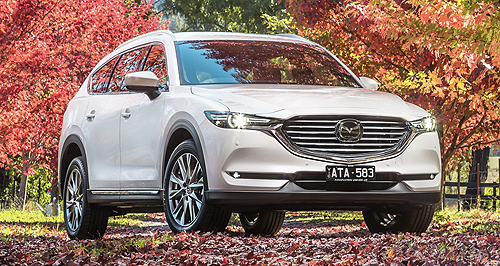News - MazdaCX-8 completes Mazda Australia’s model line-upHigh 5: Mazda’s CX-5 is the only model in its stable to grow its share in 2018, recording 10,711 new registrations in the first five months. No new models expected from Mazda Australia until electrified powertrains3 Jul 2018 By TUNG NGUYEN MAZDA Australia says it has completed its internal combustion engine model rollout with the introduction of the diesel-only CX-8 seven-seat large SUV, with Australia the only market globally to offer four SUVs in its line-up.
Speaking at the launch of the CX-8 in Queensland last week, Mazda Australia managing director Vinesh Bhindi said the only products left to introduce locally are electrified models.
“I think after CX-8, we have a fairly wide breadth of coverage, there’s not too much more that’s left,” he said. “Future opportunities may come with different powertrains – that’s electrification, hybrid and those sorts of things – but that’s not currently available on the shopping list.”
Mazda’s home market of Japan misses out on the petrol-only CX-9, while Europe only has access to the CX-3 small crossover and CX-5 mid-sizer, and the US will not receive the new CX-8 seven-seater.
Meanwhile, China will be the only market to sell the CX-4 that is produced exclusively as a left-hand-drive model in conjunction with the state-owned FAW Group, with Mr Bhindi reiterating that it is “off the table” for Australia.
Although the CX-8 was also thought to be locked out for Australia when it was revealed in September last year, Mazda Australia marketing director Alastair Doak said the local arm’s influence helped make a strong business case to get it over the line.
“It was initially unveiled as a Japanese-only model, but we saw an opportunity,” he said.
“The fact that it is right-hand drive, the fact that it picked-up a diesel engine we already use in other models, all helps the business case because it’s all just cost/benefit ultimately.
“But the fact that Mazda (Australia) has the strength of the market to be able go up and present a business case and be heard, and people say, ‘Actually, yeah it makes sense to do it for Australia.’”
To bring the vehicle here, Mazda also had to fit the CX-8 with a speed-limiting Intelligent Speed Assistance system, a unique feature in local vehicles, which is expected to help its Australasian New Car Assessment Program (ANCAP) crash test score.
With Toyota and Holden’s factory closures marking the end of local manufacturing last year, which in turn has levelled the automotive playing field, Mr Bhindi said Mazda’s strategy of focusing on its own activities and targeting private buyers has not changed.
“(Our plan has) not really (changed) because when you think about what those brands that you just mentioned were producing, the size in terms of what they sold overall (it was quite small),” he said.
“So no, it doesn’t change our strategy, I think it changes theirs.
“From our point of view, what they do is their call, and what we do with our customers and our product range and what we offer in the market, we look at the opportunities, so CX-8 is an opportunity when it came out of Japan.
“Our sales plan is what we can see with our product portfolio … so we maximise our opportunities, our focus remains private buyers … and that focus has not changed.”
Meanwhile, Mr Doak said: “What it (the end of Australian manufacturing) has done I think, has made the market, which is super-competitive, even more competitive, so it’s been an interesting 2018 so far.
“Ultimately, we do what we do and we don’t obsess about what other brands are doing too much. We know where we want to go, we know what products we have and that’s basically what we concentrate on, but it has been super-competitive absolutely.
“We’ll do well (this year), we have quite a lot of new product actions still to come, as well as the ones we’ve done so far, so we’re pretty happy with where things are going.”
For the first five months of the year, Mazda sales have dipped 4.3 per cent to 46,875 units, while the overall market is up 2.1 per cent.
All Mazda model sales have shrunk compared to last year, with the exception of the CX-5 mid-size SUV (+2.6 per cent to 10,711 units) that is currently placed as Australia’s most popular SUV.
The MX-5 sportscar has been hit the hardest, tumbling 40.8 per cent to 433 new registrations this year, but rumours suggest an updated version with more power could land by year’s end.
Similarly, the CX-3 small crossover has dropped 4.7 per cent to 6946, but it is also expected to be offered in refreshed form before the curtain falls on 2018.
The recently facelifted Mazda6 sedan and wagon range has fallen 13.3 per cent to 1270, the Mazda3 small car has dropped 5.5 per cent to 13,763, the Mazda2 is down 9.2 per cent to 4615, and the CX-9 is 7.7 per cent off its pace of last year at 3436.
Meanwhile the 4x2 and 4x4 BT-50 workhorse has remained steady despite an update lobbing in April, just three units shy of last year’s 5704 units.
Mr Bhindi also confirmed that the next-generation BT-50 workhorse, which will be based on the Isuzu D-Max, will not receive the performance flagship treatment akin to the Ford Ranger Raptor.
“No, it’s unlikely that we will have anything like that,” he said.  Read more29th of June 2018  Driven: CX-8 to give Mazda 3000 first-year salesDiesel-only CX-8 seven-seater to lift Mazda’s large SUV share to around 10 per cent28th of June 2018  Mazda rolls out Apple CarPlay, Android AutoApple CarPlay and Android Auto coming to full Mazda range by end of 2018 |
Click to shareMazda articlesResearch Mazda Motor industry news |
















Facebook Twitter Instagram